warning MAZDA 6 2002 Suplement Owners Manual
[x] Cancel search | Manufacturer: MAZDA, Model Year: 2002, Model line: 6, Model: MAZDA 6 2002Pages: 909, PDF Size: 17.16 MB
Page 658 of 909
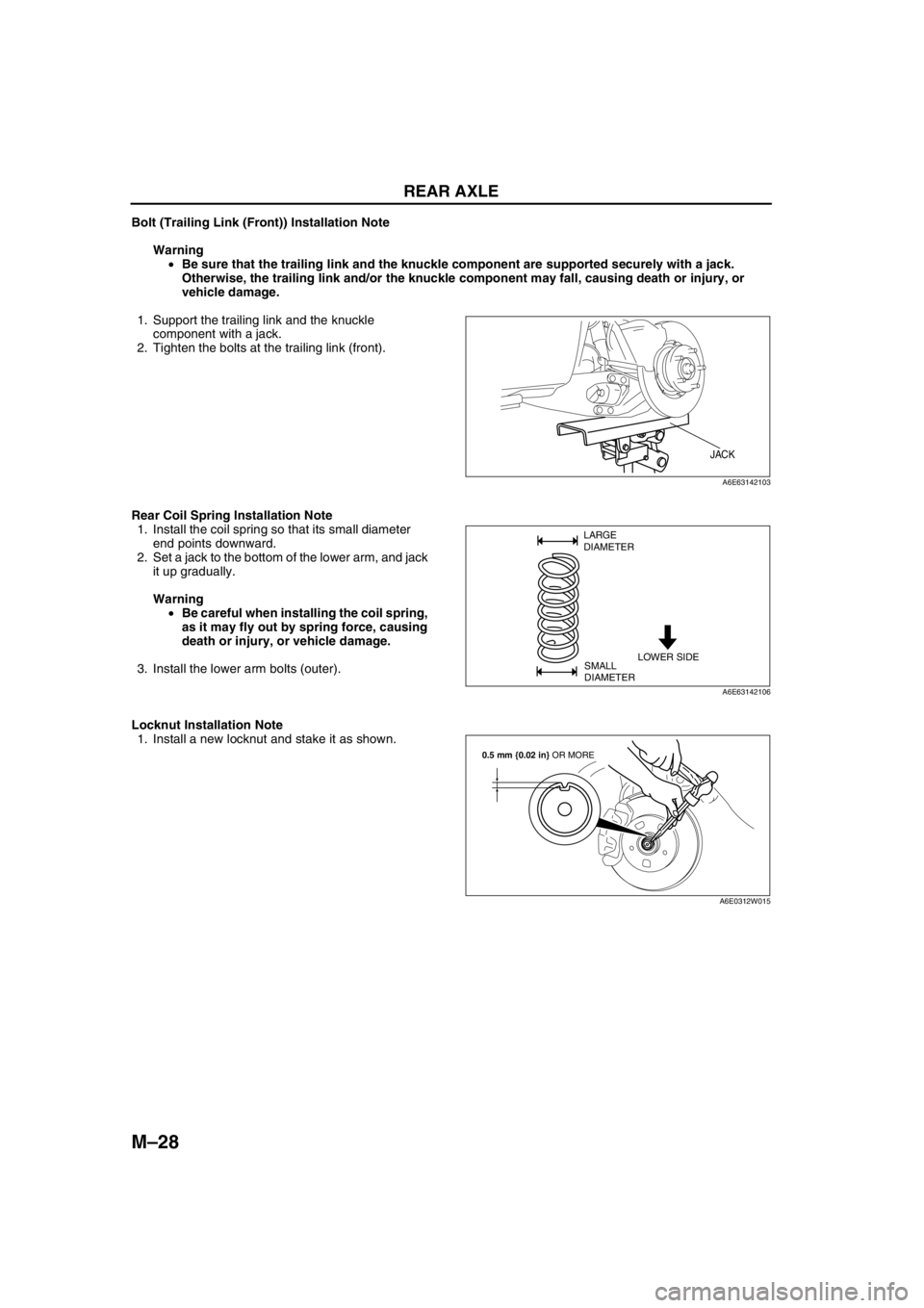
M–28
REAR AXLE
Bolt (Trailing Link (Front)) Installation Note
Warning
•Be sure that the trailing link and the knuckle component are supported securely with a jack.
Otherwise, the trailing link and/or the knuckle component may fall, causing death or injury, or
vehicle damage.
1. Support the trailing link and the knuckle
component with a jack.
2. Tighten the bolts at the trailing link (front).
Rear Coil Spring Installation Note
1. Install the coil spring so that its small diameter
end points downward.
2. Set a jack to the bottom of the lower arm, and jack
it up gradually.
Warning
•Be careful when installing the coil spring,
as it may fly out by spring force, causing
death or injury, or vehicle damage.
3. Install the lower arm bolts (outer).
Locknut Installation Note
1. Install a new locknut and stake it as shown.
End Of Sie
JACK
A6E63142103
LOWER SIDE LARGE
DIAMETER
SMALL
DIAMETER
A6E63142106
0.5 mm {0.02 in} OR MORE
A6E0312W015
Page 682 of 909
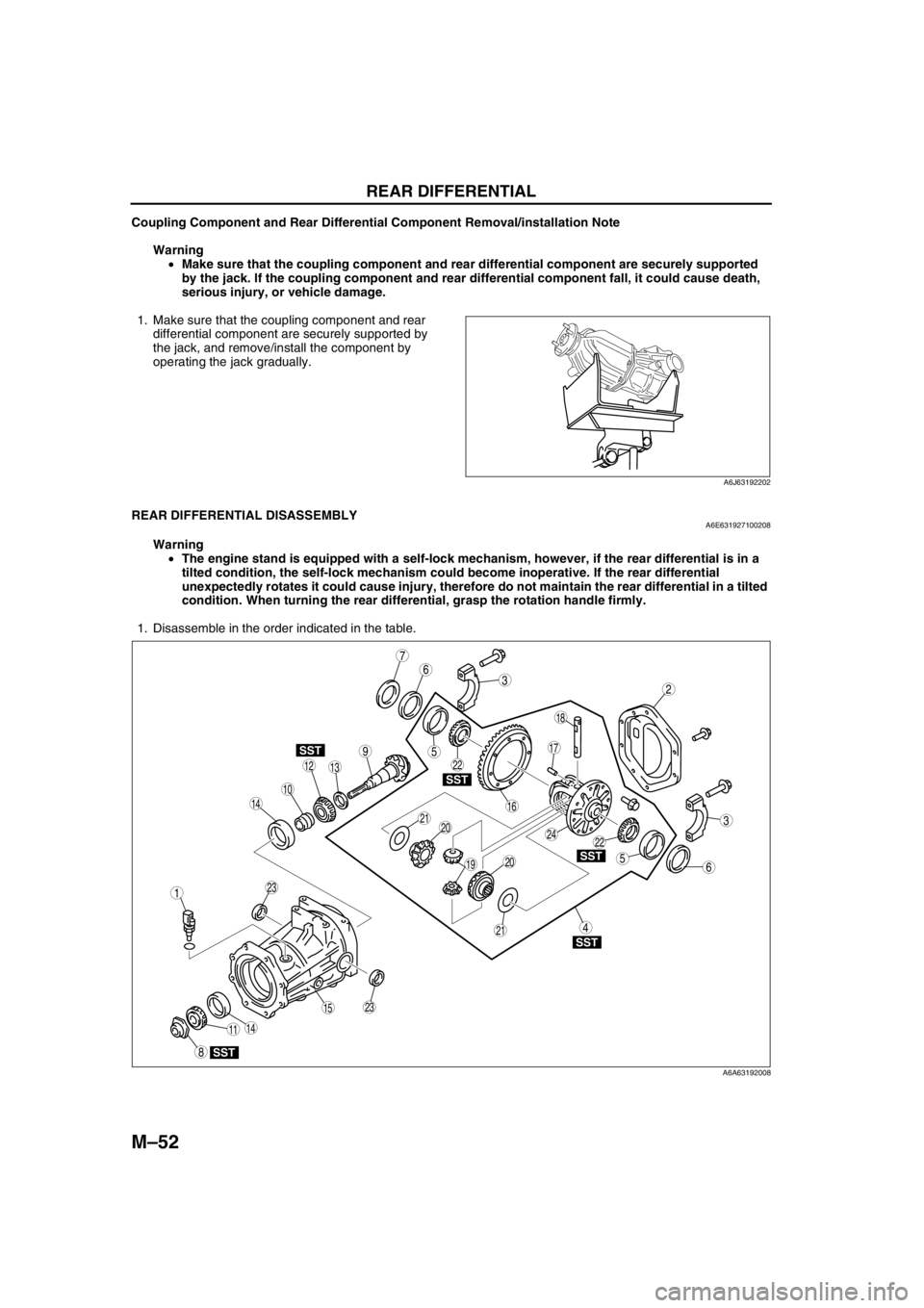
M–52
REAR DIFFERENTIAL
Coupling Component and Rear Differential Component Removal/installation Note
Warning
•Make sure that the coupling component and rear differential component are securely supported
by the jack. If the coupling component and rear differential component fall, it could cause death,
serious injury, or vehicle damage.
1. Make sure that the coupling component and rear
differential component are securely supported by
the jack, and remove/install the component by
operating the jack gradually.
End Of Sie
REAR DIFFERENTIAL DISASSEMBLYA6E631927100208
Warning
•The engine stand is equipped with a self-lock mechanism, however, if the rear differential is in a
tilted condition, the self-lock mechanism could become inoperative. If the rear differential
unexpectedly rotates it could cause injury, therefore do not maintain the rear differential in a tilted
condition. When turning the rear differential, grasp the rotation handle firmly.
1. Disassemble in the order indicated in the table.
.
A6J63192202
9
7
3
10
SST
SST
SST
SST
SST
6
18
14
14
1312
8
5
5
4
3
1
2
19
17
15
16
11
20
2024
23
23
21
21
22
22
6
A6A63192008
Page 686 of 909
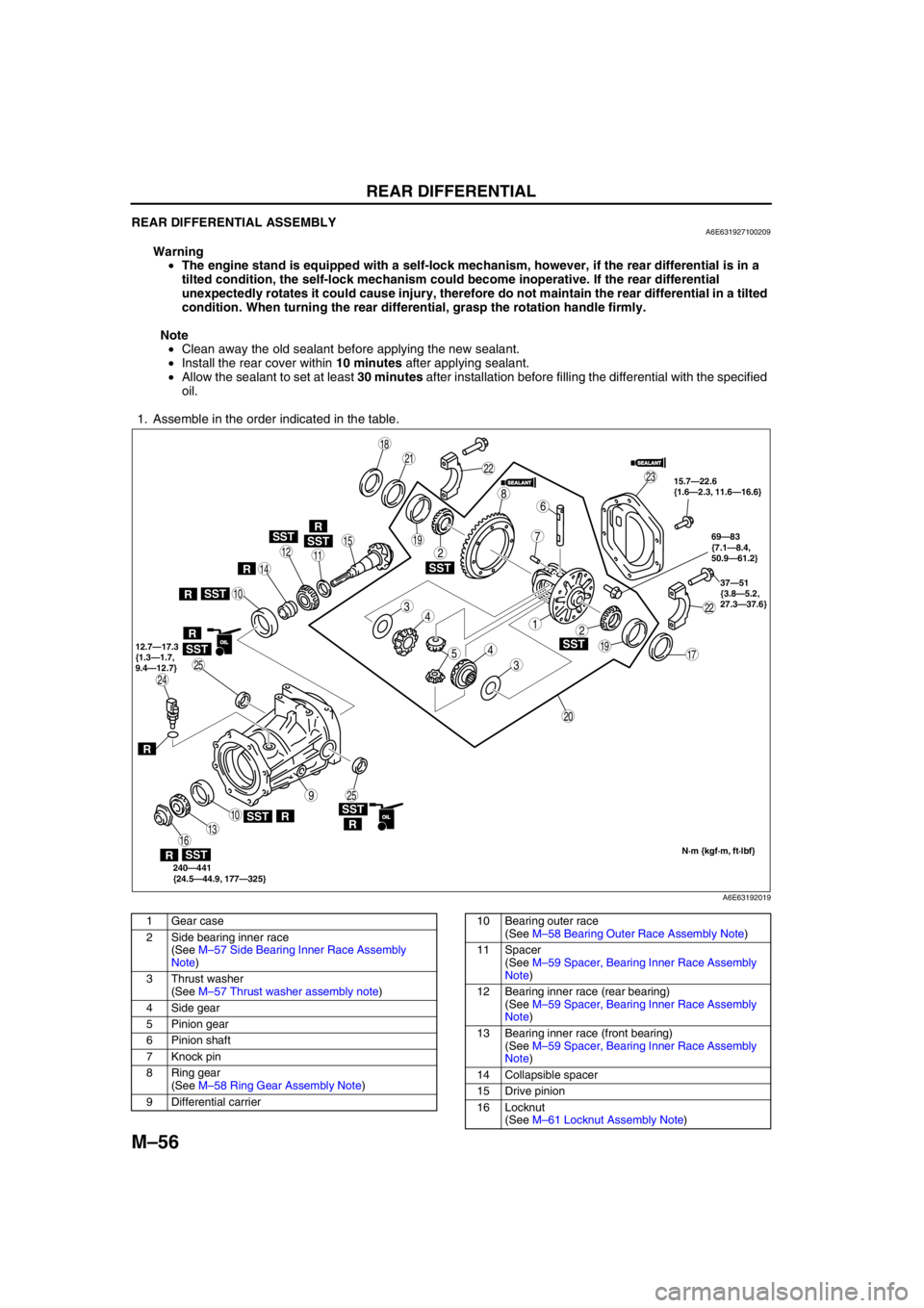
M–56
REAR DIFFERENTIAL
REAR DIFFERENTIAL ASSEMBLYA6E631927100209
Warning
•The engine stand is equipped with a self-lock mechanism, however, if the rear differential is in a
tilted condition, the self-lock mechanism could become inoperative. If the rear differential
unexpectedly rotates it could cause injury, therefore do not maintain the rear differential in a tilted
condition. When turning the rear differential, grasp the rotation handle firmly.
Note
•Clean away the old sealant before applying the new sealant.
•Install the rear cover within 10 minutes after applying sealant.
•Allow the sealant to set at least 30 minutes after installation before filling the differential with the specified
oil.
1. Assemble in the order indicated in the table.
.
SST
SST
SST
SSTSST
SST
SST
9
8
7
54
4
3
3
12
2
10
10
19
19
18
17
15
16
14
13
1112
20
25
25
24
23
21
22
22
R
SST
R
R
R
SSTR
RR
6
SEALANTSEALANT
SEALANTSEALANT
OILOIL
OILOIL
15.7—22.6
{1.6—2.3, 11.6—16.6}
37—51
{3.8—5.2,
27.3—37.6}
240—441
{24.5—44.9, 177—325} 12.7—17.3
{1.3—1.7,
9.4—12.7}69—83
{7.1—8.4,
50.9—61.2}
N·m {kgf·m, ft·lbf}
R
A6E63192019
1 Gear case
2 Side bearing inner race
(See M–57 Side Bearing Inner Race Assembly
Note)
3 Thrust washer
(See M–57 Thrust washer assembly note)
4 Side gear
5 Pinion gear
6Pinion shaft
7 Knock pin
8 Ring gear
(See M–58 Ring Gear Assembly Note)
9 Differential carrier10 Bearing outer race
(See M–58 Bearing Outer Race Assembly Note)
11 Spacer
(See M–59 Spacer, Bearing Inner Race Assembly
Note)
12 Bearing inner race (rear bearing)
(See M–59 Spacer, Bearing Inner Race Assembly
Note)
13 Bearing inner race (front bearing)
(See M–59 Spacer, Bearing Inner Race Assembly
Note)
14 Collapsible spacer
15 Drive pinion
16 Locknut
(See M–61 Locknut Assembly Note)
Page 695 of 909
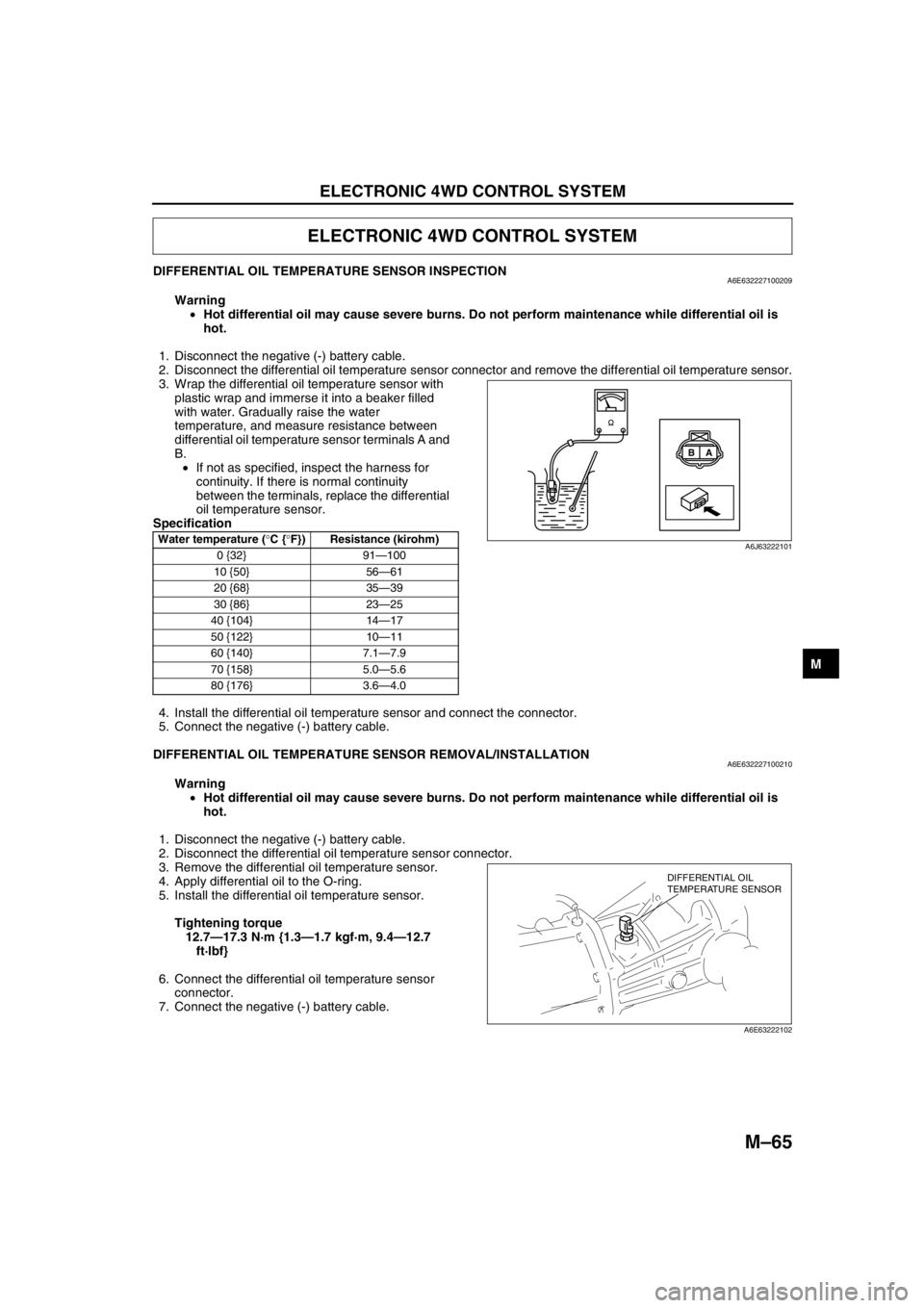
ELECTRONIC 4WD CONTROL SYSTEM
M–65
M
DIFFERENTIAL OIL TEMPERATURE SENSOR INSPECTIONA6E632227100209
Warning
•Hot differential oil may cause severe burns. Do not perform maintenance while differential oil is
hot.
1. Disconnect the negative (-) battery cable.
2. Disconnect the differential oil temperature sensor connector and remove the differential oil temperature sensor.
3. Wrap the differential oil temperature sensor with
plastic wrap and immerse it into a beaker filled
with water. Gradually raise the water
temperature, and measure resistance between
differential oil temperature sensor terminals A and
B.
•If not as specified, inspect the harness for
continuity. If there is normal continuity
between the terminals, replace the differential
oil temperature sensor.
Specification
4. Install the differential oil temperature sensor and connect the connector.
5. Connect the negative (-) battery cable.
End Of Sie
DIFFERENTIAL OIL TEMPERATURE SENSOR REMOVAL/INSTALLATIONA6E632227100210
Warning
•Hot differential oil may cause severe burns. Do not perform maintenance while differential oil is
hot.
1. Disconnect the negative (-) battery cable.
2. Disconnect the differential oil temperature sensor connector.
3. Remove the differential oil temperature sensor.
4. Apply differential oil to the O-ring.
5. Install the differential oil temperature sensor.
Tightening torque
12.7—17.3 N·m {1.3—1.7 kgf·m, 9.4—12.7
ft·lbf}
6. Connect the differential oil temperature sensor
connector.
7. Connect the negative (-) battery cable.
End Of Sie
ELECTRONIC 4WD CONTROL SYSTEM
Water temperature (°C {°F}) Resistance (kirohm)
0 {32} 91—100
10 {50} 56—61
20 {68} 35—39
30 {86} 23—25
40 {104} 14—17
50 {122} 10—11
60 {140} 7.1—7.9
70 {158} 5.0—5.6
80 {176} 3.6—4.0
A B
A6J63222101
DIFFERENTIAL OIL
TEMPERATURE SENSOR
A6E63222102
Page 699 of 909
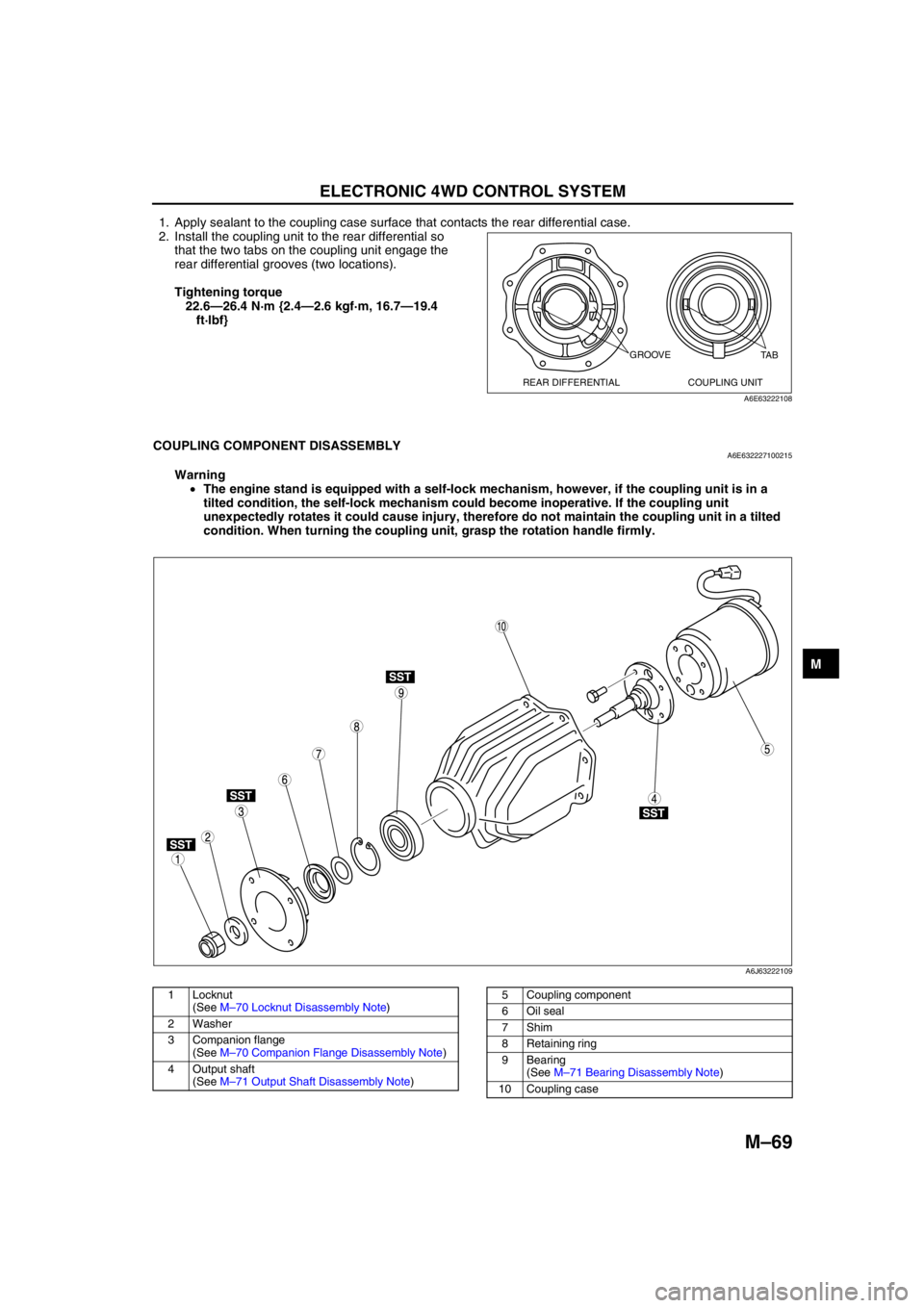
ELECTRONIC 4WD CONTROL SYSTEM
M–69
M
1. Apply sealant to the coupling case surface that contacts the rear differential case.
2. Install the coupling unit to the rear differential so
that the two tabs on the coupling unit engage the
rear differential grooves (two locations).
Tightening torque
22.6—26.4 N·m {2.4—2.6 kgf·m, 16.7—19.4
ft·lbf}
End Of Sie
COUPLING COMPONENT DISASSEMBLYA6E632227100215
Warning
•The engine stand is equipped with a self-lock mechanism, however, if the coupling unit is in a
tilted condition, the self-lock mechanism could become inoperative. If the coupling unit
unexpectedly rotates it could cause injury, therefore do not maintain the coupling unit in a tilted
condition. When turning the coupling unit, grasp the rotation handle firmly.
.
GROOVE
REAR DIFFERENTIAL COUPLING UNITTA B
A6E63222108
SST
SST
SST
SST
9
8
75
4
3
1
2
10
6
A6J63222109
1 Locknut
(See M–70 Locknut Disassembly Note)
2Washer
3 Companion flange
(See M–70 Companion Flange Disassembly Note)
4 Output shaft
(See M–71 Output Shaft Disassembly Note)5 Coupling component
6Oil seal
7Shim
8 Retaining ring
9 Bearing
(See M–71 Bearing Disassembly Note)
10 Coupling case
Page 702 of 909
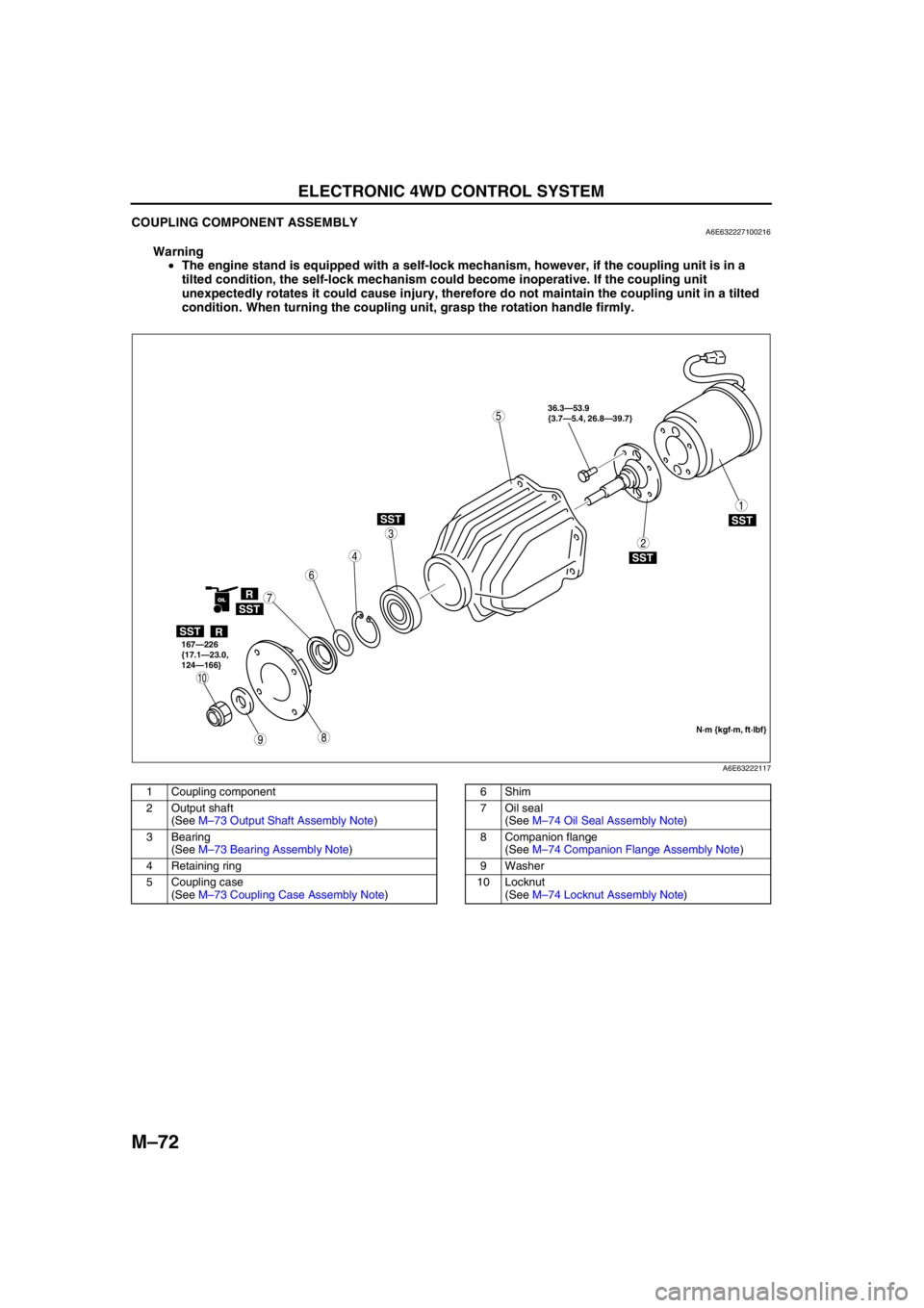
M–72
ELECTRONIC 4WD CONTROL SYSTEM
COUPLING COMPONENT ASSEMBLYA6E632227100216
Warning
•The engine stand is equipped with a self-lock mechanism, however, if the coupling unit is in a
tilted condition, the self-lock mechanism could become inoperative. If the coupling unit
unexpectedly rotates it could cause injury, therefore do not maintain the coupling unit in a tilted
condition. When turning the coupling unit, grasp the rotation handle firmly.
.
98
7
5
4
3
1
2
10
6
SST
SST
R
SST
SST
SST
R
OIL
36.3—53.9
{3.7—5.4, 26.8—39.7}
167—226
{17.1—23.0,
124—166}
N·m {kgf·m, ft·lbf}
A6E63222117
1 Coupling component
2 Output shaft
(See M–73 Output Shaft Assembly Note)
3 Bearing
(See M–73 Bearing Assembly Note)
4 Retaining ring
5 Coupling case
(See M–73 Coupling Case Assembly Note)6Shim
7 Oil seal
(See M–74 Oil Seal Assembly Note)
8 Companion flange
(See M–74 Companion Flange Assembly Note)
9Washer
10 Locknut
(See M–74 Locknut Assembly Note)
Page 712 of 909

M–82
TROUBLESHOOTING
FOREWORDA6E638027100202
End Of Sie
SYMPTOM TROUBLESHOOTINGA6E638027100203•Verify the symptoms, and perform troubleshooting according to the appropriate number.
End Of Sie
NO.1 FREQUENT FRONT WHEEL SLIPA6E638027100204
Warning
•During simulation driving, vehicle stability may decrease extremely and cause an accident. Be
sure to perform the simulation test driving in a safe area.
Malfunction vehicle delivered
Questionnaire
Verify malfunction symptoms
Symptom troubleshooting
Verify that malfunctions have been repaired
Troubleshooting completedConfirm all customer problems using a questionnaire.
Confirm malfunction on actual vehicle.
DTC inspection
Inspect for DTCs using WDS or equivalent.
Perform applicable troubleshooting inspection according to
diagnostic index.
A6E63802001
No. Symptom Description
1 Frequent front wheel slip Front wheels slip frequently during acceleration on low-friction road.
2
Tight corner braking effectBrakes seem to be applied during tight cornering while driving very
slowly on paved road.
3 Abnormal noise and/or vibration from
coupling unitThere is abnormal noise and/or vibration from coupling unit during
driving.
1 Frequent front wheel slip
[TROUBLESHOOTING HINTS]
•Tire traction performance is extremely poor for given road friction. (4WD system is normal.)
•Improper wheel alignment (4WD system is normal.)
•Rear differential oil temperature is extremely high (Fail-safe condition)
•Differential oil temperature sensor malfunction (Fail-safe condition)
•Compare slip frequency with another vehicle of the same model (under the same road conditions and tire traction
performance).
•Replace tires with others of the same model and perform test under the same road conditions to determine if the
malfunction was caused by tire traction performance.
•Coupling component malfunction
•4WD solenoid malfunction
Page 725 of 909
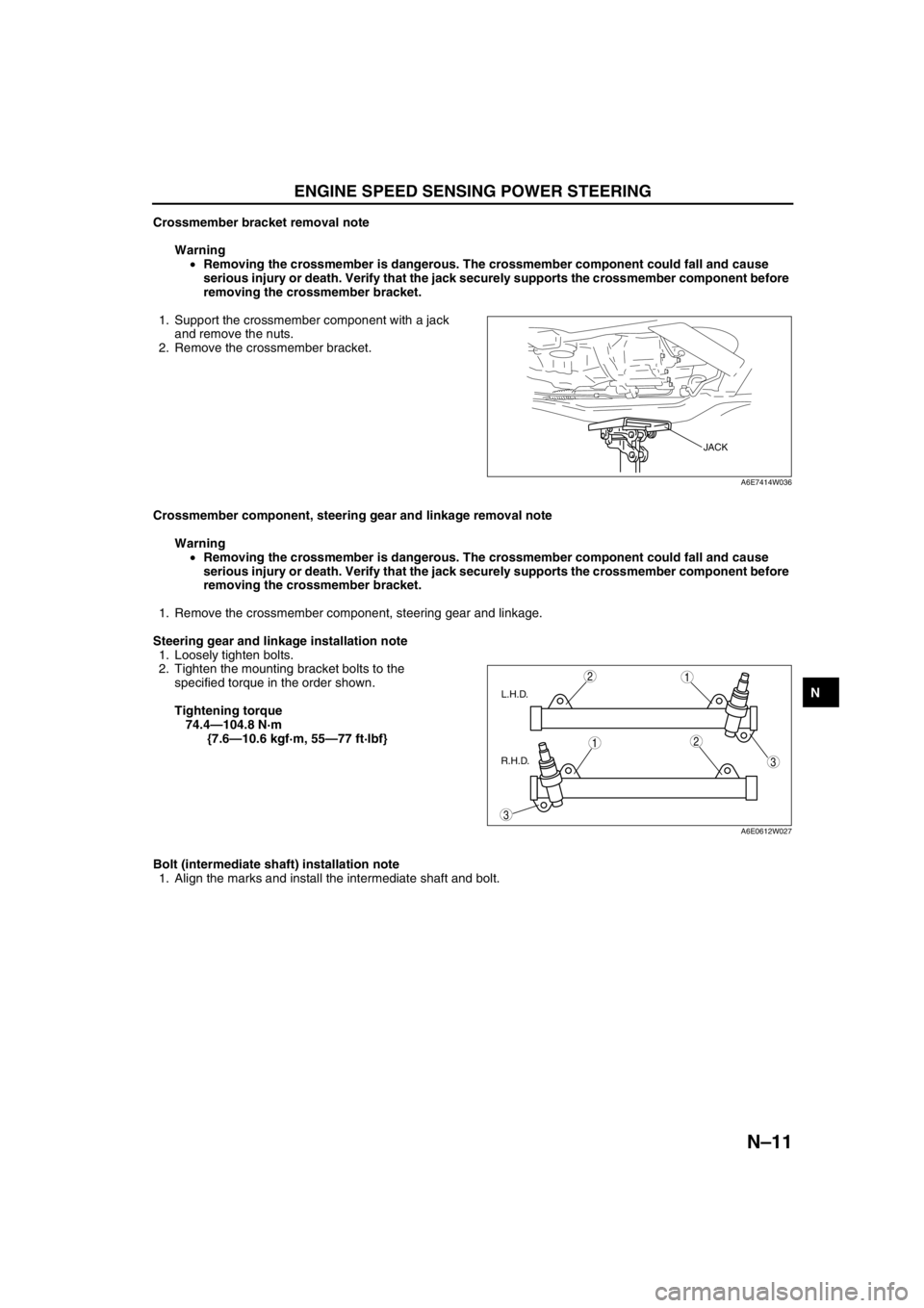
ENGINE SPEED SENSING POWER STEERING
N–11
N
Crossmember bracket removal note
Warning
•Removing the crossmember is dangerous. The crossmember component could fall and cause
serious injury or death. Verify that the jack securely supports the crossmember component before
removing the crossmember bracket.
1. Support the crossmember component with a jack
and remove the nuts.
2. Remove the crossmember bracket.
Crossmember component, steering gear and linkage removal note
Warning
•Removing the crossmember is dangerous. The crossmember component could fall and cause
serious injury or death. Verify that the jack securely supports the crossmember component before
removing the crossmember bracket.
1. Remove the crossmember component, steering gear and linkage.
Steering gear and linkage installation note
1. Loosely tighten bolts.
2. Tighten the mounting bracket bolts to the
specified torque in the order shown.
Tightening torque
74.4—104.8 N·m
{7.6—10.6 kgf·m, 55—77 ft·lbf}
Bolt (intermediate shaft) installation note
1. Align the marks and install the intermediate shaft and bolt.
JACK
A6E7414W036
3
3
1
1
2
2
L.H.D.
R.H.D.
A6E0612W027
Page 737 of 909
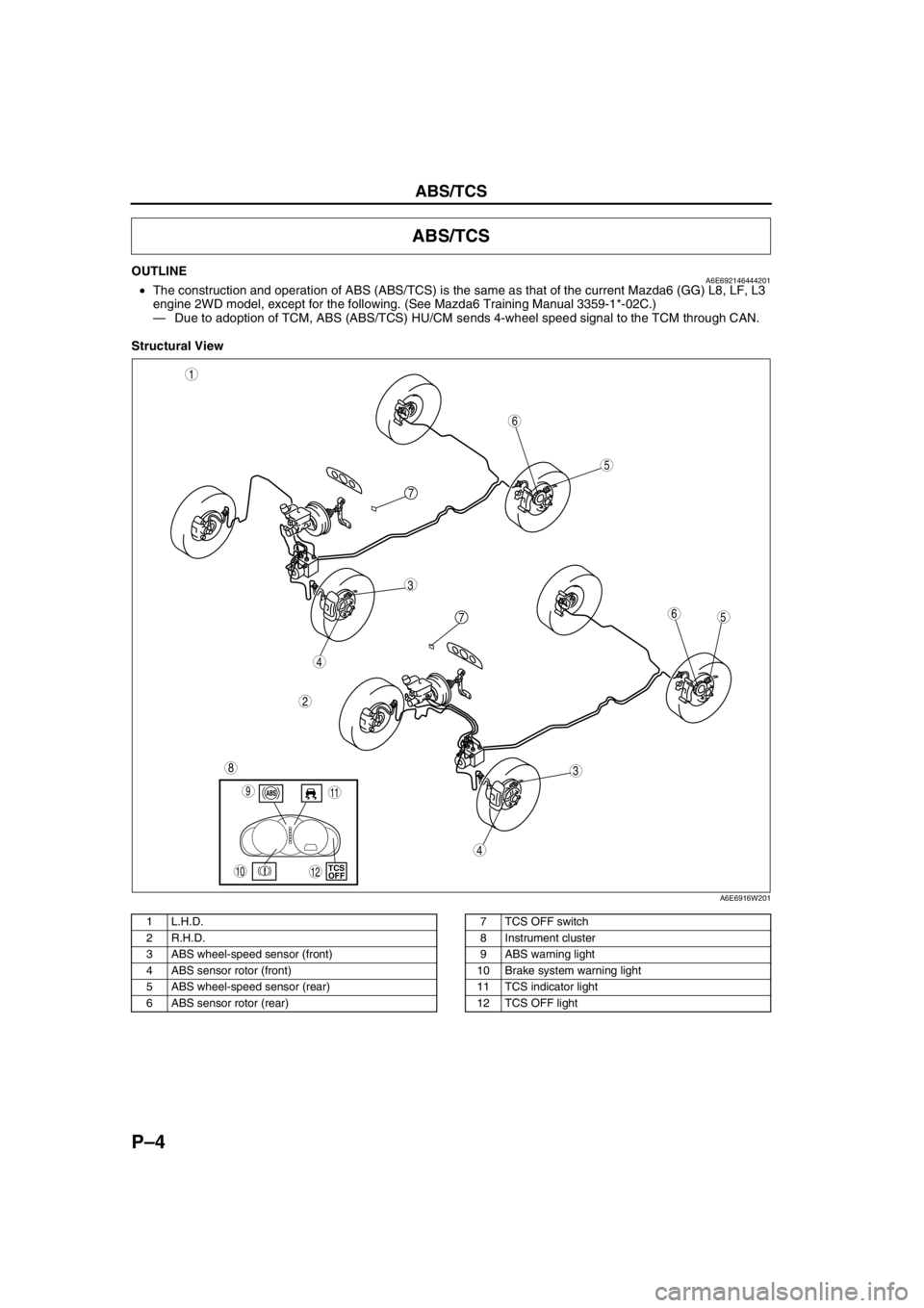
P–4
ABS/TCS
OUTLINEA6E692146444201•The construction and operation of ABS (ABS/TCS) is the same as that of the current Mazda6 (GG) L8, LF, L3
engine 2WD model, except for the following. (See Mazda6 Training Manual 3359-1*-02C.)
—Due to adoption of TCM, ABS (ABS/TCS) HU/CM sends 4-wheel speed signal to the TCM through CAN.
Structural View
.
ABS/TCS
5
3
1
2
6
7
5
3
6
8
4
4
7
9
10TCS
OFF
11
12
A6E6916W201
1 L.H.D.
2 R.H.D.
3 ABS wheel-speed sensor (front)
4 ABS sensor rotor (front)
5 ABS wheel-speed sensor (rear)
6 ABS sensor rotor (rear)7 TCS OFF switch
8 Instrument cluster
9 ABS warning light
10 Brake system warning light
11 TCS indicator light
12 TCS OFF light
Page 738 of 909

ABS/TCS
P–5
P
System Diagram
.
End Of Sie
9
9
8
7
5
43
12
6
18
17
15
16
14
13
11
12
RF
FL
RR
RL
PCMG
E
FI Z
U
D
A
B
C
Y
AC
X
V O
R ADAB AA
ABS/TCS HU/CM
pP
9
10
19
920
A6E6921W201
1 IG switch
2SUS 15 A fuse
3 ABS 60 A fuse
4 Meter
5 ABS warning light
6 Brake system warning light
7 TCS OFF light
8 TCS indicator light
9CAN driver
10 Brake light11 Cruise actuator
12 TCS OFF switch
13 DLC-2
14 CAN-H
15 CAN-L
16 ABS Wheel-speed sensor
17 Battery
18 Brake switch
19 Audio unit, Wiper and washer switch, Car-navigation
unit, Auto leveling control unit
20 TCM, 4WD CM